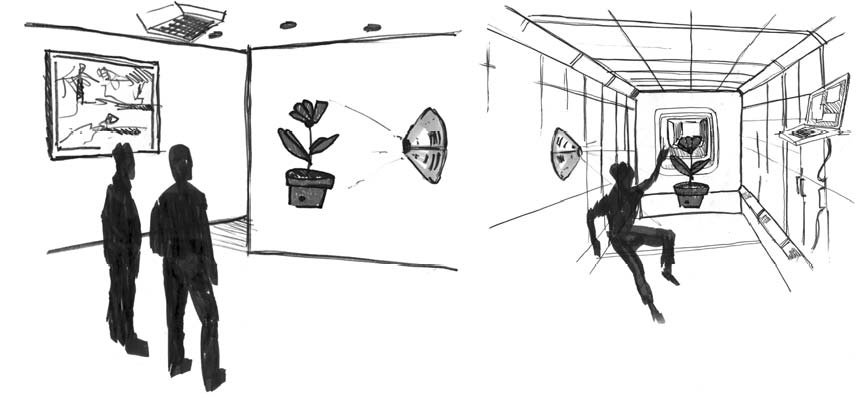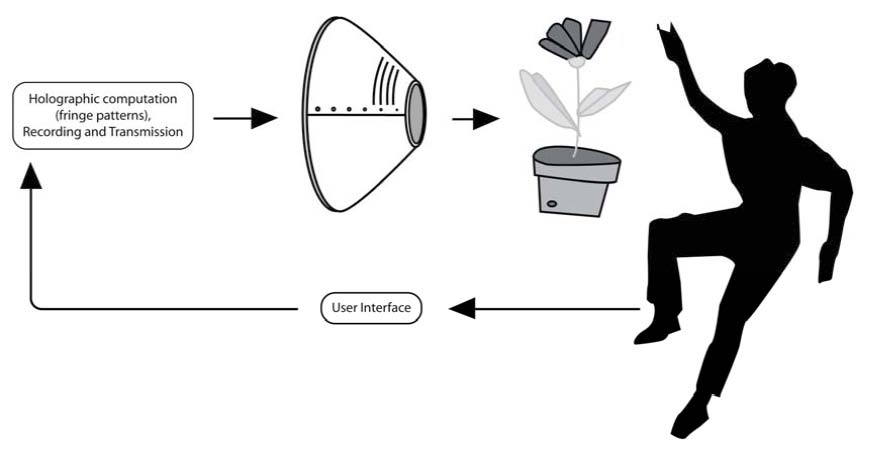João Graciano, André Oliveira, Hugo Simoes – Hologrames: Projecting Art into Space – 2004
First publication workshop Space: Science, Technology and the Arts in collaboration with ESA/ESTEC, 2004
Art is an essential part of life. We encounter art in different forms, colours, textures and smells on a daily basis. These stimuli are absent in Space. Therefore it is essential to transmit and exhibit Art in Space. To achieve this a very high degree of interaction, realism and 3D dimensionality is required. Considering the physical constraints in Space vehicles, an electro-holographic system like holovideo, although expensive, seems the appropriate choice[3]. Holographic displays would not only allow us to exhibit art, but to create a better environment for humans outside Earth.
1. Introduction
Space remains, to a large extent, an unknown environment to humans. It is however an ever-fascinating source of interest and curiosity. Today’s astronauts, cosmonauts and taikonauts are paving the way for the future Space explorers, scientists, Space tourists and even Mars colonists. But wherever they are, humans need to express feelings and ideas. This, in turn, leads to the creation of art, which has been an essential part of life since the dawn of time: pre-historic men expressed the wonder and adventure of their hunting trips through paintings in the caves; ancient Egyptians painted hieroglyphs on the walls of pyramids and temples; during the Renaissance, the new intellectual and artistic directions could be found in grand palaces; and with the advent of television and Internet, our homes have become flooded with views and ideas of modern life. Art is now available to (almost) everyone everywhere on Earth.
The next step?
To make it available also in Space.
On Earth, we have all the resources required to make art: to make a sculpture, to make a painting, to compose a musical piece – we have access to several means and mediums for presenting our art. Space, on the other hand, is a harsh environment where our resources are (still) scarce, constraints dominate and the physical space, as well as budgets, are limited. These constraints take on an even greater role as we start to go further away from the “security” of our home planet [7][8].
In this paper we propose that the best compromise is achieved by using holograms, either static or electro-holographic systems otherwise known as holovideos.
Ideally, a 3-dimensional communication of Art would provide a much more involving and interacting vehicle for an artistic expression without the burden of investment in resources.
Currently being developed in several laboratories around the world (Spatial Imaging Group at the MediaLab, M.I.T., for example), the technology of holographic images and movies could provide astronauts with three-dimensional objects and actions otherwise almost impossible to obtain in the 3D-contstrained environment of a Space station such as the International Space Station (ISS).
Furthermore, by showing holographic projections both on Earth and in Space, physical frontiers would be broken, creating a bond between life on Earth and life in Space.
2. Applications
But what kind of art could one take into Space?
It would be possible to show already existing art. All the classical works of art could be available in Space – imagine almost touching Michaelangelo’s David with the setting sun as background! Astronauts could be given the opportunity to enjoy their favourite painting, sculpture, poem, photograph or dance. If you love Tchaikvosky’s Nutcracker why not appreciate it during your trip to the Lunar base?
Furthermore, contemporary and future artists should be given the opportunity to exhibit their art in Space. We envisage two ways of doing this, either by giving all the creative freedom to the artist, or by asking artists to create an art piece inspired by a particular theme (for example a specific Space mission). This could lead to interesting synergies between Space and Earth. Art could be exhibited simultaneously in Space and in museums on Earth. Visitors of a particular museum could enjoy the same art, at the same time as astronauts on their way to the rims of the Solar System.
Taking it one step further, people on Earth could be encouraged to interact and modify the artwork they are viewing, for example in a museum’s interactive exhibition. People in Space could then observe these changes in real-time, and in turn introduce their experiences into the same art pieces which would then evolve as an appealing exchange of experiences between Earth and Space (Fig. 1).
Another way to improve this exchange of views could be, for example, the organization of school contests of drawings or messages conveying children’s feelings about Space, that would be shared everywhere. This would have the advantage of contributing to the development of artistic skills in youngsters.
Finally, art could be chosen with the objective of providing a relaxing atmosphere. Long-duration stays in Space have been known to cause psychological issues among astronauts [7][8] and can have serious consequences in their cognitive and perceptual/motor skills. These issues, and more particularly those related with the workload of the astronauts (e.g. work overload and underload) and their psychosocial situation (e.g. absence of family and friends) could be mitigated through the exhibition of Art in a holovideo system. Imagine yourself seeing something soothing that will help you relax on your 1-year trip to Mars (be it films of friends and family, an underwater scene or rolling waves on your favourite beach).
All these applications will require a very high degree of interaction, realism and 3D dimensionality. Considering the physical constraints in Space vehicles, an electro-holographic system like holovideo, although expensive, seems the appropriate choice[3].
This technology has already been established and accepted [1] and several 3-D displays have been developed and tested [1,2,3]. In fact, holography seems to be the only possible technique that can provide all the depth cues such as binocular disparity, occlusion and motion parallax which increase the realism of images and contribute to an almost palpable experience [2].

3. Holography overview
Holograms are records of the complex interference patterns between light reflected off objects illuminated by a coherent light source and a reference light source (also coherent). To visualize a hologram, one has to illuminate it, causing the light beam to interact with the recorded interference pattern. This optical wavefront reconstruction makes the image appear to be physically present.
Holography can be divided into two fields, optical holography and electro-holography (or computer holography).
3.1. Optical Holography
Holograms first appeared in 1948 and became practical in the 1960’s when coherent monochromatic laser light became available. The principle of optical holography consists in recording, on a photosensitive medium, the intensity pattern resulting from the interference of light reflected by the object to be recorded with a mutually coherent reference beam, typically a laser. The reference beam allows the medium to record both magnitude and phase of the incident object wavefront, effectively recording variation in both the intensity and the direction of the light. To reconstruct an image, the recorded interference pattern (the « fringe » pattern) modulates an illuminating beam of light. The modulated light diffracts and reconstructs a 3-D replica of the wavefront that was scattered from the object scene. The image possesses all the depth cues exhibited by the original object, including continuous parallax and ocular accommodation [2].
3.2. Electro-holography
Electro-holography generates 3-D holographic images from a 3-D description of a scene. This process involves many steps which can be grouped into two main processes: a computational stage in which the 3-D description of the scene in converted into a holographic fringe, and an optical stage, in which light is modulated by the fringe [3]. This spatial modulation of the computer-generated fringe is done by a 3-D holographic display that imitates the reconstruction step in optical holography. The main problem with electro-holography resides in the computation of the holographic fringes which require demanding computational power. Several strategies resembling 3-D computer graphics ray-tracing have been developed for the computation of the holographic fringes [4].
The first methods used were based on the calculus of the phase and amplitude of the object wavefront at the plane of the hologram through the use of Fourier transforms. They attempted to produce fringe patterns that closely resembled the fringes recorded in optical holography. These methods proved too slow and inefficient for the computation of 3-D images [2]. Other methods are based on this one but introduce several improvements.
One of these methods, the Bipolar intensity approach computes only the fringe pattern resulting from the interference pattern the object wavefront and the reference beam ignoring the object self-interference and the reference beam bias. The absence of object self-interference noise and reference bias are some of the advantages of using the bipolar intensity computation. This method also allows the linear summation of elemental fringes (with each elemental fringe representing a single image element) [4]. Pre-computed elemental fringes constituted an improvement on the bipolar intensity approach increasing the efficiency of computer generated holograms considerably.

“Real time 3D holographic displays are expensive, new and rare »[3]. Despite that, we can start thinking about their real Implementation in Space. Earlier in this section we saw that the main difficulty with electro-holography is the computation of the holographic fringes, which still require intense computational power (the first holomovie had a size of 50 cm3; the latest holomovies have the size of 1000 cm3, 20 times bigger). But that computation could be made on Earth, and the holomovie transmitted or carried on a storage device to the Space vehicle, where it could be seen the same way we see DVDs in our homes. Current electronic-holographic displays still require a reasonable amount of space (about 2 meters in length) mainly due to the optical part of the system. But the way technology is evolving and if the investigation effort in this area continues it is foreseeable that in a few years more powerful (in terms of computational power, enabling real-time transmission or hologram computation in Space vehicles) and compact systems will become available.
4. Conclusions
Nowadays, we are still in the beginning of Space exploration: we are sending probes to other planets, moons and comets, we are sending humans into orbit and even further. And now the time has come to think about sending them much further away… to Mars.
But this humanization of Space has to be twofold: as we send humans to other places in the Solar System and beyond, we have to make the Space environment a more human friendly one – and what better way of doing that then through Art?
On Earth, creating Art is a common possibility: we have the resources, and it’s a matter of having the inspiration. But in Space, those resources are scarce, and environments are heavily constrained. Because of that, we proposed that the best compromise is achieved by using holograms, either static or electro-holographic systems (otherwise known as holovideos). A holovideo-based system would be a space-saving, cost-effective way of providing astronauts with Art, which is (or should be) an essential part of the life of every human being.
It is never too soon to start thinking about holovideo applications and the advantages they could bring to Human beings here on Earth, and to those that are far away from their home planet, connecting both just like an umbilical cord.
Acknoledgements
The authors wish to thank Kati Liedevaara for her valuable suggestions to this paper.
References
[1] Halle, M. W., Multiple viewpoint rendering for three-dimensional displays, PhD. Thesis, Massachussets Institute of Technology, June 1997
[2] Lucente, M. and Galyean, T., Rendering Interactive Holographic Images, in Computer Graphics Proceedings, ACM SIGGRAPH, pp.387-394, August 6-11, 1995
[3] Lucente, M., Interactive three-dimensional holographic displays: seeing the future in depth, in Computer Graphics, vol.31, number 2, pp.63-67, May 1997
[4] Lucente, M., Benton, S.A. and St.-Hilaire, P., Electronic holography: the newest, presented at the International Symposium on Three Dimensional Imaging and Holography, Osaka, Japan, November 1994
[5] Lucente,M., St.-Hilaire, P., Benton, S.A., Arias, D.L., and Watlington, J.A., New approaches to holographic video, SPIE Proceedings #1732 « Holographic International ’92 », paper 1732-48, July 1992
[6] Nwodoh, T.A. and Benton, S.A., Chidi holographic video system, SPIE Proceedings of Practical Holography, vol.3956, 2000
[7] Harris, R.A. (ed.), HUMEX: Study on the Survivability and Adaptation of Humans to Long-Duration Interplanetary and Planetary Environments, ESA Publication SP-1264, November 2003
[8] Lane, H.W., Sauer, R.L. and Feedback, D.L., Isolation – NASA experiments in closed-environment living, advanced human life support enclosed system, Science and Technology Series, vol.104, American Astronautical Society
©João GRACIANO, André OLIVEIRA, Hugo SIMOES & Leonardo/Olats, mai 2004, republished 2023
Leonardo/Olats
Observatoire Leonardo des Arts et des Techno-Sciences
À propos / About | Lettre d'information Olats News



Pour toute (re)publication, merci de contacter / For any (re)publication, please contact Annick Bureaud: info@olats.org
Pour toute question concernant le site, merci de contacter / For any issue about the website, please contact: webmaster@olats.org
Design Thierry Fournier
© Association Leonardo 1997-2022